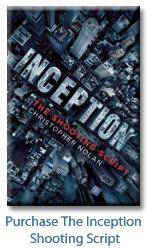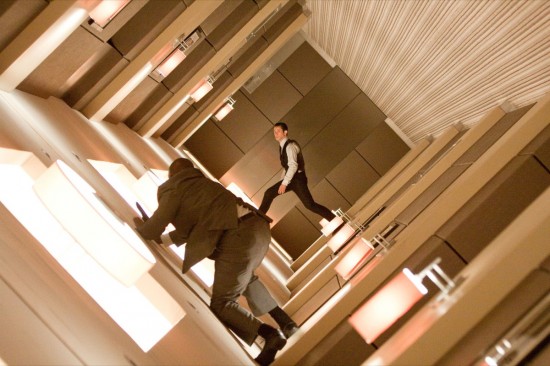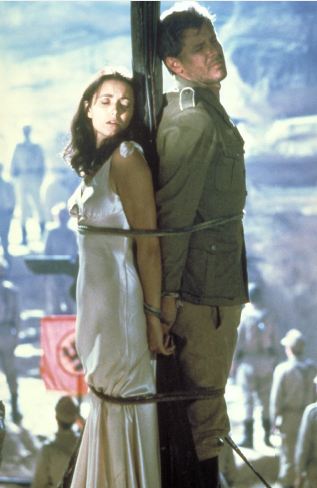Inception Screenplay

Listen to the Inception Podcast:
[audio:http://traffic.libsyn.com/storymapspodcast/Episode_Four_-_Inception_Podcast_1.mp3]
Christopher Nolan and his co-screenwriter Jonathan Nolan used the Story Maps method to structure the screenplay of Inception. If you analyze the narrative, you will see every one of the elements of the “Basic” and “Full” Story Map.
The most important element in the Inception screenplay is the GOAL of the protagonist, COBB, played by Leonardo DiCaprio. It is so important to this particular story that it covers up potentially problematic story decisions and inhabits three of the nine main dramatic elements in the Basic Story Map…
Cobb’s External Goal, Internal Goal AND his Character Arc is to reunite with his children. That’s it. The method by which he will accomplish this is the plot, which is held together by the 11 crucial story beats that make up the Beat Sheet in the Full Story Map. It is only by building and perfecting these elements ahead of time so that they all generate conflict, work within the “story logic” of the film and generate strong lines of action that the script and film succeed. This is why it is absolutely crucial that you write from a detailed, rock-solid outline. A great screenplay is a finely-tuned machine that must always MOVE FORWARD, so you cannot waste time by writing off the cuff, producing pages and pages of undisciplined scenes.
Purchase the E-Book
Story Maps: How to Write a GREAT Screenplay
NOW
The first challenge of Inception is that much of the story takes place in the dream world, wherein the normal rules  of physics do not apply and one cannot die but can merely get stuck for long periods of time. So not only must the writers define all the “rules” of this new world and create stakes and consequences so there is a real sense of danger, but since they chose to introduce the “big heist” plot at the Midpoint, halfway through the film, they must hold the audience’s interest up that point. It is Cobb’s goals and arc that hold us because he has gained our sympathy and rooting interest. We know that all of the sequences and set pieces leading up to the big mission are all leading in the same direction: for Cobb to reunite with his children.
of physics do not apply and one cannot die but can merely get stuck for long periods of time. So not only must the writers define all the “rules” of this new world and create stakes and consequences so there is a real sense of danger, but since they chose to introduce the “big heist” plot at the Midpoint, halfway through the film, they must hold the audience’s interest up that point. It is Cobb’s goals and arc that hold us because he has gained our sympathy and rooting interest. We know that all of the sequences and set pieces leading up to the big mission are all leading in the same direction: for Cobb to reunite with his children.
The mission is launched by Saito (Ken Watanabe), who hires Cobb to plant an idea in the head of his rival. The reason why he wants this is explained very briefly (something to do with preventing an energy monopoly?), and only in dialogue (and a few paltry visual aids). So how do the writers get away with motivating the entire plot with only a few lines of dialogue spoken by a man who’s proven to be untrustworthy?
In short, because it doesn’t matter.

All that matters is that Cobb gets his kids back. Saito is giving him the method to achieve this goal (In screenplay terms, the Story Engine. The Story Map defines a Story Engine for each of the four Acts.) and that’s all we care about. But this is only achieved because the writers have gained our Sympathy for Cobb.
Sympathy is crucial. I see too many scripts and movies these days in which we’re given no reason to like our hero. You can have an anti-hero if you’d like and they can do awful things, but they still need to be motivated by a moral core and probably should be pursuing a goal that we believe in. If their goal is a cynical one or to hurt someone else, it’s going to be tough for us to emotionally invest in them.
In Inception, Cobb’s goal for the Story Engine for Act Two-B is to brainwash a man he does not know, who in fact is dealing with a father on his deathbed. The obvious device to offset this would be to make the man, Robert Fischer (played by Cillian Murphy) an awful person; to show him willfully hurting an innocent. This is done in every revenge story ever told. But they don’t do that. Why? Say it with me now…
Because we know that the only way for Cobb to get back to his children is to plant the idea in Cillian Murphy’s subconscious. And that’s more important than some billionaire’s son’s hurt feelings and, you know, damaged brain or whatever.
So what’s standing in Cobb’s way?
Purchase the E-Book
Story Maps: How to Write a GREAT Screenplay
NOW
Firstly, the most complicated dream mission ever attempted: navigating three levels of subconscious to pull off an inception, which has only been done once, by Cobb on his wife, MAL. Who also happens to inhabit another of the Basic Story Map elements: the Main Dramatic Conflict. Mal is the villain, the Antagonist. But she’s not a living person, only a subconscious projection of Mal. How to make a ghost (for lack of a better term) enough of an obstacle to threaten the entire mission? Firstly, they define a rule in which one can get trapped in the dream world for years, and secondly they show us previous scenes in which Mal ruins a “sub-mission” before we get to the big one. We know what she’s capable of.
But we still know that you can’t really die in a dream — the killing blow will provide a “kick” that bounces you out of the dream state.
So they built in the element of the sedative that is so strong that if they attempt to kick too soon, they may never wake up. And if the dreamer “host” gets stuck in time, they will all be stuck.
Following the rule of Escalating Conflict, what happens right away when the big mission starts? The one character who must make it back to consciousness to ensure that Cobb sees his kids, Saito, is shot and is bleeding to death, blocking their kick out of the dream and condemning them to years in limbo unless they can figure out a way out of this mess. In story terms, this adds a ticking time clock of urgency on top of the already urgent timeline of the mission. And to take it even further…the impossible three-level mission has now added a fourth level. This takes us into Act Three, which is actually the fourth Act in the Full Story Map since Act Two is separated into A and B.
Hold on, this is getting complicated, right? I’m not even sure if I’ve got it all straight! So let’s get back to Basics. I mean, Basic. Story Map. Which defines the Theme.
So what’s it all about? What are the writers saying? If you think about it, a film about what takes place in a man’s mind must touch on the Theme of identity, right? (I don’t know if this is the Controlling Theme, necessarily, but it is an important one)
Is Cobb a killer? Did he kill his wife? Can he actually pull off an inception?
This theme is no surprise, considering Christopher Nolan’s filmography…
MEMENTO:
- The central mystery is who is the identity of the killer? By the end we realize it’s really been about who is our protagonist?
INSOMNIA:
- Is our protagonist a corrupt cop? Did he shoot his partner to cover up his crimes?
THE PRESTIGE:
- Who is the real magician, Jackman or Bale?
- Who are the ‘clones’ of Jackman and Bale that allow them to achieve the “transporting man?”
BATMAN BEGINS:
- Can Bruce Wayne become Batman, a crusader for justice who will save Gotham City?
- Who is Rhas Al Ghul?
THE DARK KNIGHT:
- Is Bruce Wayne the same as Batman? Can he separate himself and give up the Batman persona?
(go here for more about the Story Map of The Dark Knight)
INCEPTION:
- Is Cobb ruled by his own guilt? Can he leave it behind, in essence escape Mal’s grasp and find redemption/become a new person?
Or maybe the question of identity goes like this: Has this ALL been Cobb’s dream? Has it all been a projection of his unconscious? There’s plenty of evidence to back this up in the film, but it’s never conclusively proven.
Purchase the E-Book
Story Maps: How to Write a GREAT Screenplay
NOW
The most important thing, in terms of craft, is that Nolan builds these question/s of identity into the lines of action in each script. (A line of action is composed of the scenes that show a character actively pursue a goal) The complicated interweaving of plot lines, character arcs and thematic symbols is the signature of Nolan’s work.

All of Christopher and Jonathan Nolan’s screenplays can be outlined with the screenplay structure method which I call Story Maps. Analyzing your favorite movies with this tool can show you how the magic is made on the page before it ever gets to the screen.
 You can learn how to develop your own concept for a movie into a powerful narrative that employs the story structure used by 95% of modern movies and the form that I was looking for as a Senior Screenplay Analyst for commercial production companies and major studios that produced movies like Chicago, Scream, Gangs of New York, Chocolat, One Fine Day, The Game and Ulee’s Gold.
You can learn how to develop your own concept for a movie into a powerful narrative that employs the story structure used by 95% of modern movies and the form that I was looking for as a Senior Screenplay Analyst for commercial production companies and major studios that produced movies like Chicago, Scream, Gangs of New York, Chocolat, One Fine Day, The Game and Ulee’s Gold.
Please don’t hesitate to contact me with any questions about Story Maps or how I can work with you to develop your own movie idea.
-Dan Calvisi
https://actfourscreenplays.com/
copyright (c) Daniel Calvisi
The E-Books Story Maps: How to Write a GREAT Screenplay and Booster Pack #1 include Full Story Map analyses of 19 hit movies, primarily from the last decade.
These successful films are great examples of professional screenwriting in many different genres and budget levels aimed at varied audiences. I stand by each title as a strong example of its genre and as a primer to learn the screenwriting craft at the level that you need to be: the “submission ready” tier that makes a good script into a GREAT script.
Read more about the Booster Pack.
Purchase the Story Maps E-Book and the Booster Pack at a special bundled rate.
Good Luck and Happy Writing!
-Dan
Related: Free Full Story Map: The Dark Knight
Related: Free Story Map sample: Raiders of the Lost Ark
Related: Free Story Map sample: Sex and the City movie




I have a question, I’ve always been interested in writing a film, however I was looking at the dark knight complete story map, and I was wondering, on sequels, do you still use the same external goals and skill and misbehavior… For instance on the sequel to the dark knight, will they have exactly physical strength/agility, and incredible technology as the skill part, or fo they just use the same and also add some new qualities.. and what would be the theme to a sequel for the dark knight, because Batman want’s to save Gotham and the police are now after him, thank-you for answering my question
That’s a good question. The answer is probably not, especially with goals, since you’d want the sequel to stand on its own with a new thematic focus and a new arc of change for your protagonist so you’d build in mostly new Basic Story Map elements (which are your main dramatic elements, the building blocks of the hero and the dramatic situation before you construct the plot). But, of course, Bruce/Batman would still have great strength and technical skills, so you wouldn’t just abandon those traits; but you would probably want to create a new ‘misbehavior’ to add some conflict and contrast to this phase of his growth.
IMHO, it’s always best to differentiate sequels with different types of character growth. For example, Bruce Wayne is a different person at the beginning and end of Batman Begins as he is in The Dark Knight. His arc in Batman Begins is more one of finding his new identity as The Batman whereas in The Dark Knight it’s the question of him retiring Batman and returning to just being Bruce Wayne, or perhaps the new Bruce, actually happy with Rachel at his side. Can Batman retire when faced with the greatest threat Gotham has ever seen, The Joker? The answer is the synthesis that Bruce finds at the end of The Dark Knight.
The next Batman film *may* see a return to the arc of Batman Begins, considering the similarities in parts one and three of other franchises; for example, Indy’s arc in Raiders of the Lost Ark and The Last Crusade are very close — the plot beats are almost identical, btw. Same with Die Hard and Die Hard with a Vengeance.
It will be exciting to see what Nolan and crew have in store for us in the summer of 2012! I just hope Bale stays healthy, considering his extreme weight loss (once again) for “The Fighter.” :-0
-Dan
It makes sense that he’s actually in reality at the end, but just doesn’t want to know if it’s reality or not anymore because he’s with his kids and that’s the only thing that matters to him.
Talladega,
I haven’t seen any actual page excerpts yet, but the customer reviews say there’s a lot more in the book: “I was expecting just a straight screenplay, but the book also includes an interview with Nolan, storyboards, concept art and schematics of the “PASIV” device they use to enter dreams. Very cool.”
Another reviewer mentions that they added scenes in the film to make things clearer, like the cutting between all the “kick” moments in the different levels, which reminds me of THE SIXTH SENSE draft that I read back in the day — it didn’t contain the flashbacks that showed Bruce Willis in the rooms with people that weren’t seeing him, so the reveal of his being dead/a ghost wasn’t as clear in the script as in the film.
The ol’ “SHOW, Don’t Tell” rule doncha know!
Is the bound screenplay in proper format or like many published scripts where it’s in some kind of hybrid format with a bunch of italics and bolds? I hope it’s the real thing, how it looked when he handed out the scripts to the cast and crew.
Since it’s Nolan supervising this book himself I’m going to trust it’s the real deal. Purchasing mine now!
Nolan cannot fail to deliver. Inception was worth the wait -- I’d wait another ten years for structure like this!